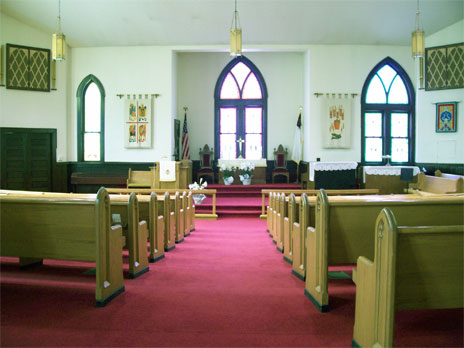
This situation, like so many others, started with a failing electronic organ- this time in a historic church which was about to celebrate its 100th anniversary. There had never been a pipe organ at Crim, but more importantly for us, the building was never intended to accommodate one. We then had the challenge of building an organ in an extremely limited space, but which nonetheless had the resources to do everything expected of it. What was built was an organ containing six pipe ranks (on direct-acting electric chests), and one electronic voice (more on that later). The organ could be considered a “unit” organ, with every rank playing at more than one pitch (usually), but with careful design, the usual pitfalls of unit design were avoided. Here is the list of ranks:
Gedeckt 8’, 85 pipes
Principal 8’ 73 pipes
Salicional 8’ 49 pipes
Vox Celeste 8’, 49 pipes
Octave 4’, 61 pipes
Quint 1 1/3’, 49 pipes
Bourdon 16’, electronic, 32 notes
Without boring everyone with too much detail, I’ll point out a couple of features of the tonal design. You notice that the Octave 4’ has 61 pipes? That rank plays on the Great manual at 4’ pitch only. The ramification of this is that if one draws the principal chorus on the Great, there are no octave-duplications at all (for example, a single rank playing at both 8’ and 4’ pitches). This means that no notes ever “drop out” during hymn playing, or when playing any sort of contrapuntal music. Also, note that the Quint is a separate rank- by playing at only 2 2/3’ and 1 1/3’, it can be tuned to pure intervals, unlike unit ranks which necessarily be somewhat out of tune when played at mutation pitches. With regard to the electronic Bourdon, there simply wasn’t any room for a set of real Bourdons in the chamber. It was a difficult decision to use the electronic tone production in this organ, but it is absolutely musically effective. Also, while some low end would be lacking, the organ was designed to work independently of the electronic tones- the organ would still be perfectly useable and playable without them.
GREAT
16’ Bourdon TC
8’ Principal
8’ Gedeckt
8’ Salicional
4’ Octave
2’ Fifteenth
1 1/3’ Quint
Swell to Great
16’ Bourdon TC
8’ Principal
8’ Gedeckt
8’ Salicional
4’ Octave
2’ Fifteenth
1 1/3’ Quint
Swell to Great
SWELL
16’ Bourdon TC
8’ Montre
8’ Gedeckt
8’ Salicional
8’ Vox Celeste TC
4’ Flute d’Amour
2 2/3’ Nazard TC
2’ Piccolo
16’ Bourdon TC
8’ Montre
8’ Gedeckt
8’ Salicional
8’ Vox Celeste TC
4’ Flute d’Amour
2 2/3’ Nazard TC
2’ Piccolo
PEDAL
16’ Bourdon (electronic)
16’ Lieblich Gedeckt (electronic)
8’ Principal
8’ Gedeckt
5 1/3’ Quint
4’ Octave
4’ Gedeckt Flute
Great to Pedal
Swell to Pedal
16’ Bourdon (electronic)
16’ Lieblich Gedeckt (electronic)
8’ Principal
8’ Gedeckt
5 1/3’ Quint
4’ Octave
4’ Gedeckt Flute
Great to Pedal
Swell to Pedal
Crim Memorial United Methodist Church, Philippi, West Virginia, Opus 2 (2004)

